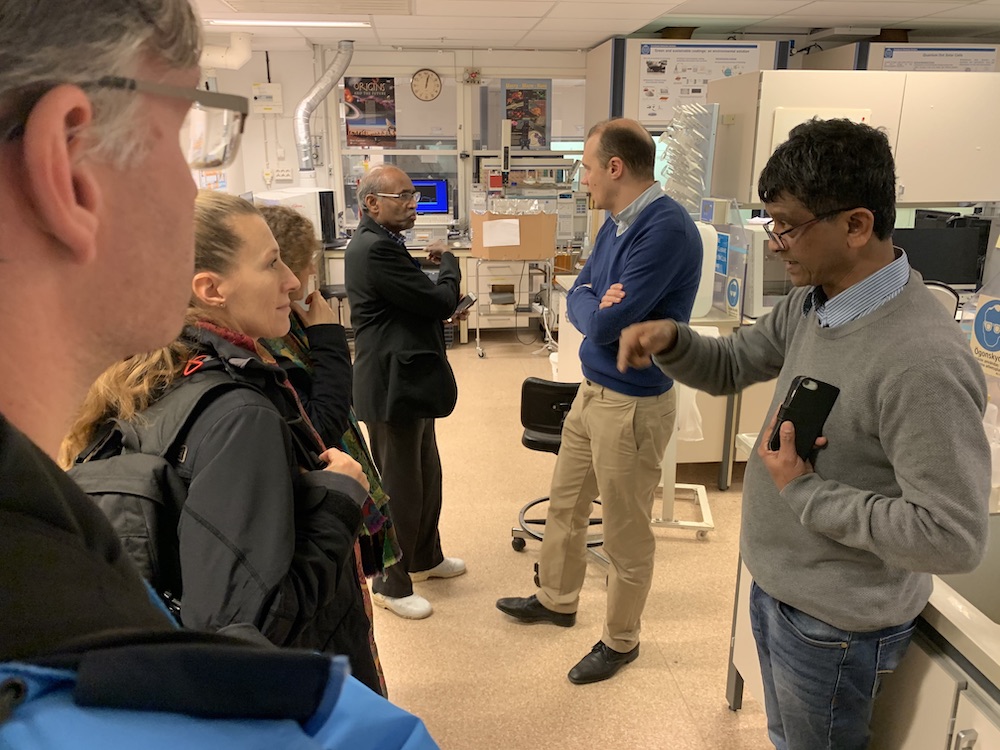Better ways of extracting and storing energy with new materials
School visit, Energy Platform, School of Engineering Sciences (SCI)

During the Energy Platform's visit to the School of Engineering Sciences, Department of Applied Physics in Kista, there was a meeting of researchers from the divisions of Photonics and of Material and Nano Physics. Here, there was an emphasis on everything from new forms of solar cells to materials research for better batteries.
Joydeep Dutta, Professor of Functional Materials, revealed more about the development of functional nanomaterials. Particular mention was made of the "Blue Energy" (Salt Power) project. This is where energy is extracted by utilising the diffusion between fresh and salt water.
When seawater meets fresh water, such as at the mouth of a river, the two become mixed, with the aim of achieving equilibrium. The aim is to utilise the process in order to extract energy using nanomaterials. Experiments with testing equipment are taking place in the laboratory with promising results, and the equipment is due to be scaled up for testing on a larger scale.
The research into nanomaterials also aims to develop better solar cells and to extract hydrogen from cellulose. This research is supported by the Swedish Research Council, Vinnova and Mistra, among others.
Sebastian Lourdudoss, Professor of Applied Physics, presented research into highly efficient multilayer solar cells on silicon. Here, methods are developed for combining so-called III-V material (e.g. Gallium Arsenide and indium phosphide) with silicon in order to ̈increase the efficiency of solar cells and also at a lower cost.
In the Electrum clean-room facility, the researchers can allow the III-V materials to grow out on top of silicon wafers. The research is supported by the Swedish Energy Agency, among others.
Semi-transparent solar cells could be used to cover the windows on buildings or vehicles and turn them into energy producers, explained Ilya Sychugov. By using quantum dots, nanometre-small silicon crystals, the light can be captured to then be routed out to the edges where it is converted to energy.
The researchers have produced polymeric material with 70 per cent light conversion frequency in order to demonstrate the technology, and they are continuing the work with support of the Swedish Energy Agency.
Martin Månsson, associate professor, works with materials research for applications in batteries, as well as additional storage and conversion of energy. The field also includes quantum materials. The work is carried out at the MAX IV laboratory and European Spallation Source (ESS) in Lund, among others, as well as in collaboration with industry.
Among other things, he raised concerns about a dependency on lithium deposits in South America that resembles the historical dependency on oil-producing countries. New alternative battery materials can include sodium and potassium. Månsson emphasised that there is still poor understanding of many of the current battery materials, despite the continued increase in their use.
Månsson is also Director of Studies for the graduate school SwedNess – Swedish Neutron Education for Science & Society, which is a collaboration between six Swedish universities, including KTH Royal Institute of Technology. The school has received SEK 120 million in support from the Swedish Foundation for Strategic Research, SSF, and engages approximately 20 doctoral students. He is currently working on a renewal of SwedNess for an additional 20 doctoral students.
Anand Srinivasan, Professor, gave an insight into new nano-sized structures, produced from different semiconductor materials. The nanostructures can be tailored to provide better collection of light for energy conversion, among other things. The aim is to increase the efficiency of current applications, such as LED lighting or solar cells. Among others, the Swedish Research Council supports the research.
Jan Linnros, Head of Photonics, also participated in the visit. The Energy Platform was represented by Director, Lina Bertling Tjernberg, Vice Director, Christophe Duwig.
Text: Magnus Trogen Pahlén
